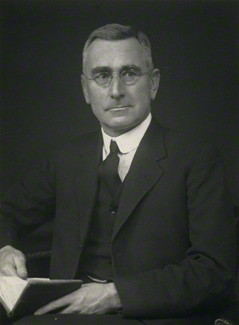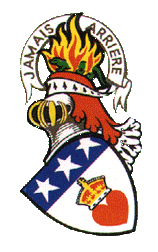Claude Gordon Douglas
 Claude Gordon Douglas(1882–1963), physiologist,
was born in Leicester on 26 February 1882, the second son of
Claude
Douglas, honorary surgeon to Leicester Royal Infirmary, and his
wife, Louisa Bolitho Peregrine, of London. Both his grandfathers
were also in medical practice: James Douglas, L.R.C.S. (Edin.), was
Consulting Surgeon to the Infirmary in Bradford and Thomas
Peregrine, M.D. (Edin.), M.R.C.P. (London), was in practice in
London.
Claude Gordon Douglas(1882–1963), physiologist,
was born in Leicester on 26 February 1882, the second son of
Claude
Douglas, honorary surgeon to Leicester Royal Infirmary, and his
wife, Louisa Bolitho Peregrine, of London. Both his grandfathers
were also in medical practice: James Douglas, L.R.C.S. (Edin.), was
Consulting Surgeon to the Infirmary in Bradford and Thomas
Peregrine, M.D. (Edin.), M.R.C.P. (London), was in practice in
London.
His elder brother, J. S.
C. Douglas, was professor of pathology at Sheffield University, and
his cousin, J. A. Douglas, was professor of geology at Oxford. He
was a scholar at Wellington College, but moved to Wyggeston grammar
school, Leicester, to study science. In 1900 he went up to Oxford,
where he was a demy of Magdalen College. In 1904 he obtained
first-class honours in natural science (animal physiology), after
which he stayed on in the physiological laboratory, working for the
research degree of BSc under the supervision of J. S. Haldane. In
1905 Douglas took up a London University scholarship at Guy's
Hospital and completed his medical degree of BM, BCh (Oxon.) in
December 1907. Six months earlier he had been elected to a
fellowship and lectureship in natural science at St John's College,
Oxford, a position he held for forty-two years. He became DM in
1913.
Douglas's scientific career falls into three parts: the
first, his collaborative work up to 1914 with J. S. Haldane on human
breathing; the second, his work during the First World War on
physiological aspects of gas warfare; and the third, back in Oxford,
after Haldane's departure from the physiological laboratory, on
general human metabolism, successively as university demonstrator
(1927), reader (1937), and titular professor (1942), and, after he
had passed the retiring age, as departmental demonstrator up to
1953.
It was Douglas's good fortune to join the physiological
laboratory when work on the regulation of body oxygen and carbon
dioxide concentrations, and exchange of these gases through the
lungs, was still developing. He quickly became the best-known and
the most permanent of the younger colleagues of Haldane, whose work
since the turn of the twentieth century had transformed the subject
of respiration. Douglas's name appears on some ten of the most
important papers over this period, which show an insight into the
principles of control physiology three or four decades ahead of
their time. Douglas and Haldane provided a quantitative description
of the transport of carbon dioxide by the blood between cells and
lungs, and the facilitatory effect on it of oxygen transport in the
opposite direction. This work complemented the earlier work of
Christian Bohr, K. A. Hasselbalch, and S. A. S. Krogh, of
Copenhagen, who had shown the facilitatory effects of carbon dioxide
on oxygen transport. Work of this kind allowed Douglas and Haldane
to develop a practical and bloodless method for measuring the rate
of pumping of blood by the human heart under various conditions.
Detailed and meticulous measurement allowed Douglas and J. S.
Haldane (with some mathematical assistance from J. B. S. Haldane) to
elucidate the equilibria between the oxygen-carrying substance
haemoglobin and the concentrations of oxygen and carbon monoxide.
They went on to show that certain conditions, notably residence at
high altitude, altered the equilibria. Ingenious reasoning led them
to conclude from this observation that oxygen could be transported
against the concentration gradient across the lung capillary
membranes (oxygen secretion). The question was open at the time, and
the resulting controversy between them and their friends Krogh and
Joseph Barcroft, of Cambridge, was one of the entertainments of
early twentieth-century physiology. Subsequent developments decided
the controversy against Oxford, but the basic observation remained
unexplained.
During this period Douglas began to measure the
rate of uptake of oxygen and of the output of carbon dioxide by
collecting expired air in a large canvas gasbag. The Douglas bag
became well known for its convenience for measuring energy
expenditure in people in various occupations.
Douglas served
in the Royal Army Medical Corps in the First World War, reaching the
rank of lieutenant-colonel. When gas warfare started in 1915, he was
the serving officer in France with the detailed knowledge and deep
understanding of respiratory physiology that allowed interpretation
of the effects of the alarming new weapon. He held several
appointments in the British expeditionary force related to gas
warfare before being appointed physiological adviser in 1917 to the
Directorate of Gas Services, where he worked with Harold Hartley. He
was awarded the MC in 1916, was four times mentioned in dispatches,
and was appointed CMG in 1919. He contributed extensively to the
official history of the war, and Hartley felt that his chapter
dealing with the development of gas warfare was by far the best
summary of the use of the new weapon.
After the war Douglas
returned to Oxford, where he collaborated with J. G. Priestley in
setting up and running a novel and thorough practical course in
human physiology. The course was taken by all Oxford medical
undergraduates over a period of some thirty years.
After J.
S. Haldane left the physiological laboratory, Douglas's interests
moved towards the assessment of metabolic processes in humans in the
light of the new insights provided by the rapid expansion of
biochemistry. With a succession of research students, including F.
C. Courtice, he applied the new knowledge to the interpretation of
quantitative measurements. His conclusions put him in the vanguard
of those who questioned the fashionable, though erroneous, view that
carbohydrate was the sole source of energy for muscular contraction.
Between the wars the departure of Haldane and the scanty material
support received by his branch of physiology rendered difficult any
achievement in his field of interest; the Oxford laboratory was more
concerned with the exciting advances in neurophysiology of the
school of C. S. Sherrington.
During the Second World War
Douglas remained in Oxford, teaching and helping with administration
in college and the laboratory. After the war and before his final
retirement in 1953 he supervised the work of three more research
students, including Roger Bannister.
From 1920 onwards
Douglas was increasingly involved in government committee work, some
of which he took over from J. S. Haldane, on such topics as chemical
warfare, muscular activity in industry, health and safety in mines,
conditions in hot and deep mines, research on pneumoconiosis,
breathing apparatus for the National Fire Service, the Gas Research
Council, heating and ventilation of buildings, and diet and energy
requirements. As a chairman or member, Douglas prepared his papers
meticulously, listened carefully, but spoke comparatively seldom.
Douglas was a devoted senior member of St John's College, which
was his home for twenty-eight years. He was a formidable walker, and
a keen and very knowledgeable gardener and photographer. He was an
excellent host in college and at home. Douglas was unmarried and
lived with his younger sister, Margaret Douglas, for twenty-four
years.
In 1911 Douglas won the Radcliffe prize; in 1922 he
was elected FRS and was on the council of the Royal Society
(1928–30). He was an ad hominem professor at a time when
Oxford had few such. In 1945 he was awarded the Osler memorial
medal, and in 1950 he was elected to an honorary fellowship of St
John's.
Douglas's early and best-known joint work in academic
physiology probably stemmed in large part from Haldane's genius.
However, his extraordinarily high standards of accuracy, his energy,
his rare common sense and general competence must have contributed
greatly to the joint achievement. His capacity as an independent
scientist was obvious to his younger colleagues and to readers of
his writings on chemical warfare.
Douglas died in the
Radcliffe Infirmary on 23 March 1963 after a street accident in
Oxford.
Errors and Omissions
|
|
The Forum
|
|
What's new?
|
|
We are looking for your help to improve the accuracy of The Douglas
Archives.
If you spot errors, or omissions, then
please do let us know
Contributions
Many articles are stubs which would benefit from re-writing.
Can you help?
Copyright
You are not authorized to add this page or any images from this page
to Ancestry.com (or its subsidiaries) or other fee-paying sites
without our express permission and then, if given, only by including
our copyright and a URL link to the web site.
|
|
If you have met a brick wall
with your research, then posting a notice in the Douglas Archives
Forum may be the answer. Or, it may help you find the answer!
You may also be able to help others answer their queries.
Visit the
Douglas Archives Forum.
2 Minute Survey
To provide feedback on the website, please take a couple of
minutes to complete our
survey.
|
|
We try to keep everyone up to date with new entries, via our
What's New section on the
home page.
We also use
the Community
Network to keep researchers abreast of developments in the
Douglas Archives.
Help with costs
Maintaining the three sections of the site has its costs. Any
contribution the defray them is very welcome
Donate
Newsletter
If you would like to receive a very occasional newsletter -
Sign up!
Temporarily withdrawn.
|
|
|
|
|
|
|
|


